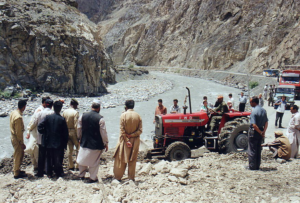Natural Hazards and Disaster Risk

This is a difficult post to write because hazard and risk mean different things to different people.
I am going to describe what they mean to me as physical scientist who researches natural hazards.
What is a Natural Hazard?
At the core of my research, I study natural hazards. These are physical events in the natural world that have the potential to be damaging. If the best place to study them is on an island in the middle of no-where, then I will go there to learn about the hazard. I want to know about the physical process that control events like earthquakes and landslides.
A process, phenomenon or human activity that may cause loss of life, injury or other health impacts, property damage, social and economic disruption or environmental degradation.
 However, this terminology gets fuzzy when the potential for a hazard is modified by human activity.
However, this terminology gets fuzzy when the potential for a hazard is modified by human activity.
- The building of roads on mountainsides in the Himalaya increases the risk of landslides.
- The clearing of land for agriculture inputs sediment into rivers that can change the likelihood and location of flooding.
- The use of fracking can lead to induced seismicity.
- Are these entirely ‘natural’? No.
Hence, the UNISDR defines hazard more generally to be:
A process, phenomenon or human activity that may cause loss of life, injury or other health impacts, property damage, social and economic disruption or environmental degradation.
What are Disasters?
The phrase “natural disaster” is very problematic. Since disasters require people, and people live in complex societies, disasters are socially constructed – so the word natural is a bit misleading. Yes, natural hazards may a initiate a disaster. However, the knowledge of the hazard alone is insufficient to describe the outcomes of an unfolding disaster. UNISDR definition of disaster:
A serious disruption of the functioning of a community or a society at any scale due to hazardous events interacting with conditions of exposure, vulnerability and capacity, leading to one or more of the following: human, material, economic and environmental losses and impacts.
What is Disaster Risk?
If you are interested in disaster risk – you also need to consider exposure and vulnerability.
If you are interested in disaster risk – it is unlikely you will be heading to an uninhabited island in the middle of nowhere to study it.
Let’s have a quick look at these concepts
Exposure is a relatively simple – it describes where and when people, homes, livelihoods and infrastructure are exposed to potential hazards. Urbanisation, the rapid growth of cities worldwide, is leading to greater concentrations of people and increasing exposure at critical locations.

Vulnerability is more nuanced, some examples of sources of vulnerability are given below.
- Physical Vulnerability: this would include the design and construction of buildings, transport and communication infrastructure, access to water…
- Social Vulnerability: social factors can include weak family structure, lack of leadership, weak or no community organisations and sources of discrimination.
- Economic Vulnerability: over-reliance on a few economic resources can make communities more vulnerable during disasters
- Attitudinal Vulnerability: a lack of willingness to work independently can lead to reliance to external factors and difficulties in responding to evolving scenarios (e.g. climate change of during an unfolding disaster)
- Dynamic Vulnerability: How vulnerability changes over time. This could be due to the consequences of either social or physical events, and more likely a complex mix of both.
Disaster risk considers potential consequences, given the range of potential hazards that are likely to occur. It needs to take into account the needs of stakeholders and end-users. It is sometimes summarised as,
Risk = Hazard x Vulnerability x Exposure
which gives a sense that when the hazard, vulnerability and exposure are all high – so is the risk. Whilst this equation gives a general sense of how risk can be described – it is quite a simplistic formulation.
Hence, the UNISDR defines disaster risk as:
The potential loss of life, injury, or destroyed or damaged assets which could occur to a system, society or a community in a specific period of time, determined probabilistically as a function of hazard, exposure, vulnerability and capacity.
Where can you learn more?
If you are interested in how science is being applied to reduce disaster risk, have a look at the UNISDR’s SCIENCE FOR DISASTER RISK REDUCTION Case Studies and have a critical think about the strengths and weaknesses of the different approaches
({PD-US})
(CC BY-SA 3.0, https://commons.wikimedia.org/w/index.php?curid=923696)
(By Lyn Topinka - USGS Cascades Volcano Observatory, Public Domain, https://commons.wikimedia.org/w/index.php?curid=672548)
({PD-US})
({PD-US})




Recent comments